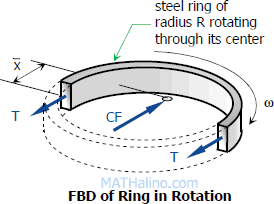Problem 140
At what angular velocity will the stress of the rotating steel ring equal 150 MPa if its mean radius is 220 mm? The density of steel 7.85 Mg/m3.
Solution 140
 $CF = M \omega^2 \bar x$
$CF = M \omega^2 \bar x$
Where:
$M = \rho V = \rho A \pi R$
$x = 2R / \pi$
Thus,
$CF = \rho A \pi R \omega^2 (2R / \pi)$